Modeling and Measuring the Leaked-Air Rate into the Insulation Layer of a Single-Aisle Aircraft Cabin
Abstract
:1. Introduction
2. Research Methods
2.1. CFD Modeling Cases and Boundary Conditions
2.2. Solution Settings and Numerical Procedure
2.3. Experiment Test and CFD Modeling Validation
3. Results
3.1. CFD Validation
3.2. Reference Case (Case 1)
3.3. Impact of Cruising Altitudes
3.4. Impact of Crack Size
3.5. Impact of Crack Location
3.6. Impact of Flow Blocker
4. Discussion
5. Conclusions
- A higher flight cruising altitude resulted in a greater leaked-air rate from the cabin to the envelope walls due to the larger temperature difference; thus, there was greater stack pressure at a higher altitude. The leaked-air rate at a cruising altitude of 12 km from the sea level was more than twice that at 8 km.
- The smaller the crack width was, the lower the leaked-air rate was. The dependence of the leaked-air rate on crack width was very strong if crack width was smaller than 2.66 mm. The leaked-air rate for a width of 1 mm was less than half of those for crack widths of 2.66 and 5 mm.
- More cracks farther away from the neutral height resulted in a greater leaked-air rate. More cracks would comprise a larger effective leakage area. A crack farther away from the neutral height corresponded to a larger stack pressure difference.
- Placing a flow blocker in the envelope wall could effectively reduce the leaked-air rate. A flow blocker in the middle of the insulation layer reduced the leaked-air rate by 34.5%.
Author Contributions
Funding
Institutional Review Board Statement
Informed Consent Statement
Data Availability Statement
Conflicts of Interest
Appendix A
| Cruising altitude from sea level (km) | 12 | 10 | 8 |
| Recovery temperature TAW (°C) | −37.30 | −21.44 | −5.58 |
| Convective heat transfer coefficient h (W/(m2·K)) | 113.19 | 149.95 | 183.99 |
| Sky radiant temperature Tsky (°C) | −121 | −107 | −93 |
| External emissivity (ε) | 0.92 | 0.92 | 0.92 |

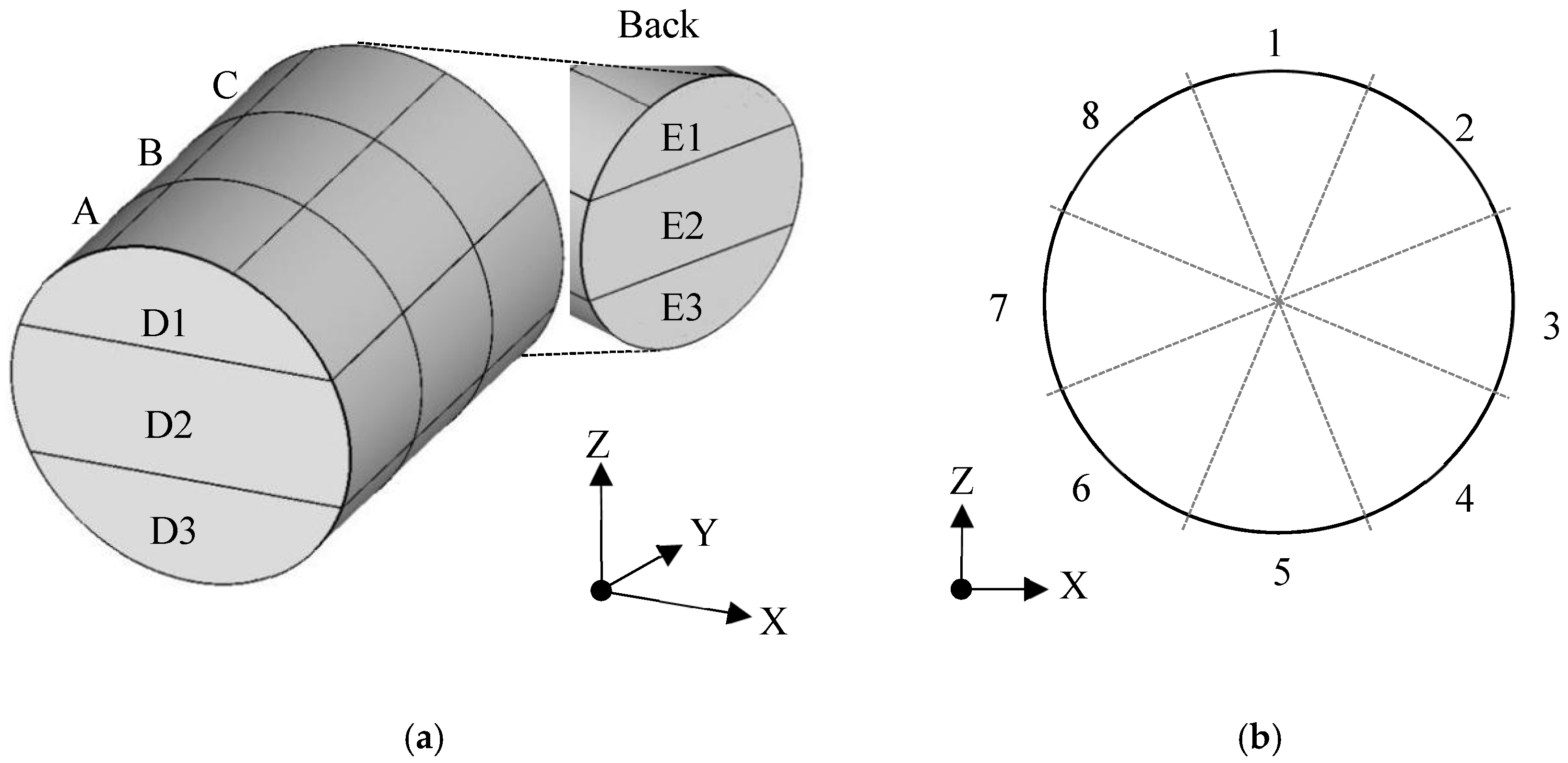
| Item | Temperature (°C) | Item | Temperature (°C) | Item | Temperature (°C) | Item | Temperature (°C) |
|---|---|---|---|---|---|---|---|
| A-1 | −12.11 | B-1 | −8.26 | C-1 | −6.72 | D-1 | −11.75 |
| A-2 | −9.54 | B-2 | −8.00 | C-2 | −7.49 | D-2 | −12.26 |
| A-3 | −8.00 | B-3 | −8.26 | C-3 | −8.77 | D-3 | −13.80 |
| A-4 | −10.05 | B-4 | −13.13 | C-4 | −9.80 | E-1 | −16.35 |
| A-5 | −15.70 | B-5 | −15.19 | C-5 | −15.19 | E-2 | −11.74 |
| A-6 | −12.37 | B-6 | −12.37 | C-6 | −13.90 | E-3 | −13.53 |
| A-7 | −10.31 | B-7 | −11.59 | C-7 | −12.62 | ||
| A-8 | −13.02 | B-8 | −11.99 | C-8 | −10.20 |

References
- ICAO. Manual of the ICAO Standard Athmosphere Extended to 80 km, 3rd ed.; Internation Civil Aviation Organization: Montréal, QC, Canada, 1993. [Google Scholar]
- Boeing Commercial Airplanes. The Airplane Cabin Environment-The Air That You Breathe; Boeing: Seattle, WA, USA, 2005. [Google Scholar]
- ANSI/AHSHRAE. ASHRAE Standarad 161–2007: Air Quality Within Commercial Aircraft; American Society of Heating, Refrigerating and Air-Conditioning Engineers, Inc.: Atlanta, GA, USA, 2007. [Google Scholar]
- Li, P.; Zhao, Y.; Wang, S. Various air distribution modes on commercial airplanes. Part 1: Experimental measurement. HVAC&R Res. 2013, 19, 268–282. [Google Scholar]
- Norrefeldt, V.; Riedl, G. Investigation of the Impact of a Particle Foam Insulation on Airflow, Temperature Distribution, Pressure Profile and Frost Buildup on the Aircraft Structure. Aerospace 2021, 8, 359. [Google Scholar] [CrossRef]
- Walkinshaw, D.S. Stack Pressure-Created Airflows in Insulation Envelopes, Part 2: Passenger Aircraft. Ashrae J. 2020, 5, 32–46. [Google Scholar]
- Zhang, T.; Li, G.; Lin, C.-H.; Wei, Z.; Wang, S. Experimental identification of key parameters contributing to moisture accumulation in an aircraft section. Build. Environ. 2017, 126, 339–347. [Google Scholar] [CrossRef]
- Zhang, T.; Li, G.; Lin, C.-H.; Wei, Z.; Wang, S. Measured moisture accumulation in aircraft walls during simulated commercial flights. Sci. Technol. Built Environ. 2018, 24, 820–829. [Google Scholar] [CrossRef]
- Brunt, C. Speech Interference Levels in Aircraft Interior Noise Measurement: Their Use and Interpretation. 2020. Available online: http://www.armchair.com/sci/brunt1.html (accessed on 3 February 2020).
- Specht, P.; Asfia, J.; Buzza, T.; von Flotow, A. Air Curtain Insulating System for Aircraft Cabin. U.S. Patent 5,897,079, 27 April 1999. [Google Scholar]
- Walkinshaw, D.S.; Preston, K.F. Controlling Cabin and Envelope Air Flows and Pressure Differentials to Prevent Envelope Condensation, Enable Cabin Humidification, Improve Fire Safety, and Decrease Fuel Use. SAE Int. J. Aerosp. 2011, 4, 1243–1253. [Google Scholar] [CrossRef]
- Huber, P.; Schuster, K.; Townsend, R. Controlling Nuisance Moisture in Commercial Airplanes, Aero. No. 5. 1999. Available online: http://www.boeing.com (accessed on 3 February 2020).
- Westhoff, A. Experimental study of moist air flow in the gap between the aircraft’s fuselage and its cabin wall. CEAS Aeronaut. J. 2020, 17, 591–607. [Google Scholar] [CrossRef] [Green Version]
- Tamura, G.T. Pressure Differences for a Nine-Story Building as a Result of Chimney Effect and Ventilation System Operation; ASHRAE: Atlanta, GA, USA, 1973; Volume 10. [Google Scholar]
- Walkinshaw Douglas, S.; Horstman, R.H. Stack Pressure-Created Airflows in Insulation Envelopes, Part 1: Buildings: Another HVAC Design Parameter to Consider. ASHRAE J. 2020, 62, 12–25. [Google Scholar]
- Arce, J.; Jiménez, M.J.; Guzmán, J.D.; Heras, M.R.; Alvarez, G.; Xamán, J. Experimental study for natural ventilation on a solar chimney. Renew. Energy 2009, 34, 2928–2934. [Google Scholar] [CrossRef]
- Man, X.; Lu, Y.; Li, G.; Wang, Y.; Liu, J. A study on the stack effect of a super high-rise residential building in a severe cold region in China. Indoor Built Environ. 2020, 29, 255–269. [Google Scholar] [CrossRef]
- Yoon, S.; Song, D.; Kim, J.; Lim, H. Stack-driven infiltration and heating load differences by floor in high-rise residential building. Build. Environ. 2019, 157, 366–379. [Google Scholar] [CrossRef]
- Kalamees, T.; Alev, Ü.; Pärnalaas, M. Air leakage levels in timber frame building envelope joints. Build. Environ. 2017, 116, 121–129. [Google Scholar] [CrossRef]
- Jo, J.-H.; Lim, J.-H.; Song, S.-Y.; Yeo, M.-S.; Kim, K.-W. Characteristics of pressure distribution and solution to the problems caused by stack effect in high-rise residential buildings. Build. Environ. 2007, 42, 263–277. [Google Scholar] [CrossRef]
- Zhang, T.; Tian, L.; Lin, C.-H.; Wang, S. Insulation of commercial aircraft with an air stream barrier along fuselage. Build. Environ. 2012, 57, 97–109. [Google Scholar] [CrossRef]
- Liu, S.; Xu, L.; Chao, J.; Shen, C.; Liu, J.; Sun, H.; Xiao, X.; Nan, G. Thermal environment around passengers in an aircraft cabin. HVAC&R Res. 2013, 19, 627–634. [Google Scholar]
- Chen, L.; Wang, S.; Li, G.; Lin, C.-H.; Zhang, T. CFD modeling of moisture accumulation in the insulation layers of an aircraft. Appl. Therm. Eng. 2016, 102, 1141–1156. [Google Scholar] [CrossRef]
- Graham, W.J.; David, F.J. The permeability of fibrous porous media. Can. J. Chem. Eng. 1986, 64, 364–374. [Google Scholar]
- Shih, T.H.; Liou, W.W.; Shabbir, A.; Yang, Z.; Zhu, J. A new k-ε eddy viscosity model for high Reynolds number turbulent flows. Comput. Fluids 1995, 24, 227–238. [Google Scholar] [CrossRef]
- ANSYS FLUENT, 19.0. In User’s and Theory Guide; ANSYS, Inc.: Canonsburg, PA, USA, 2018.

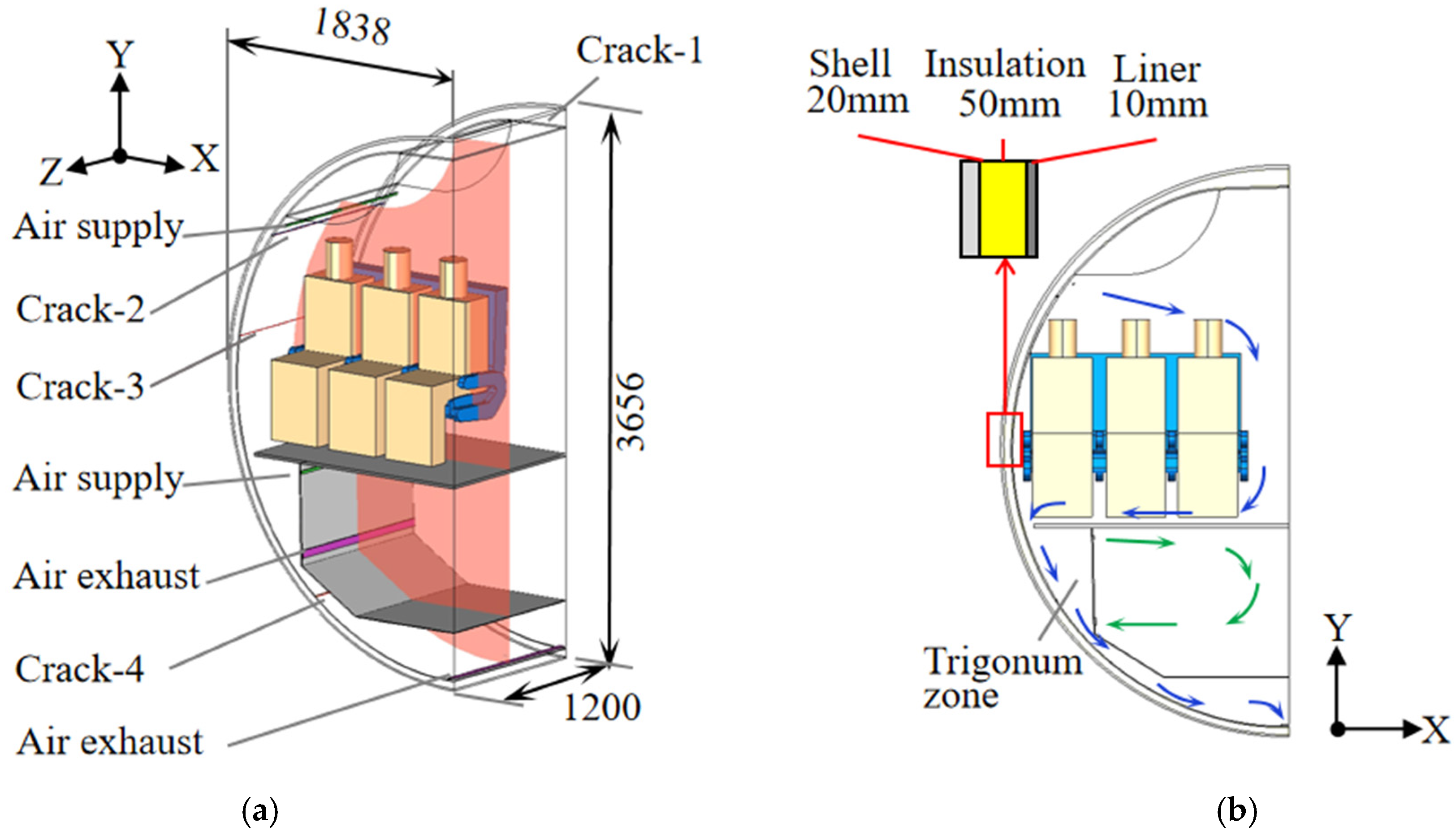
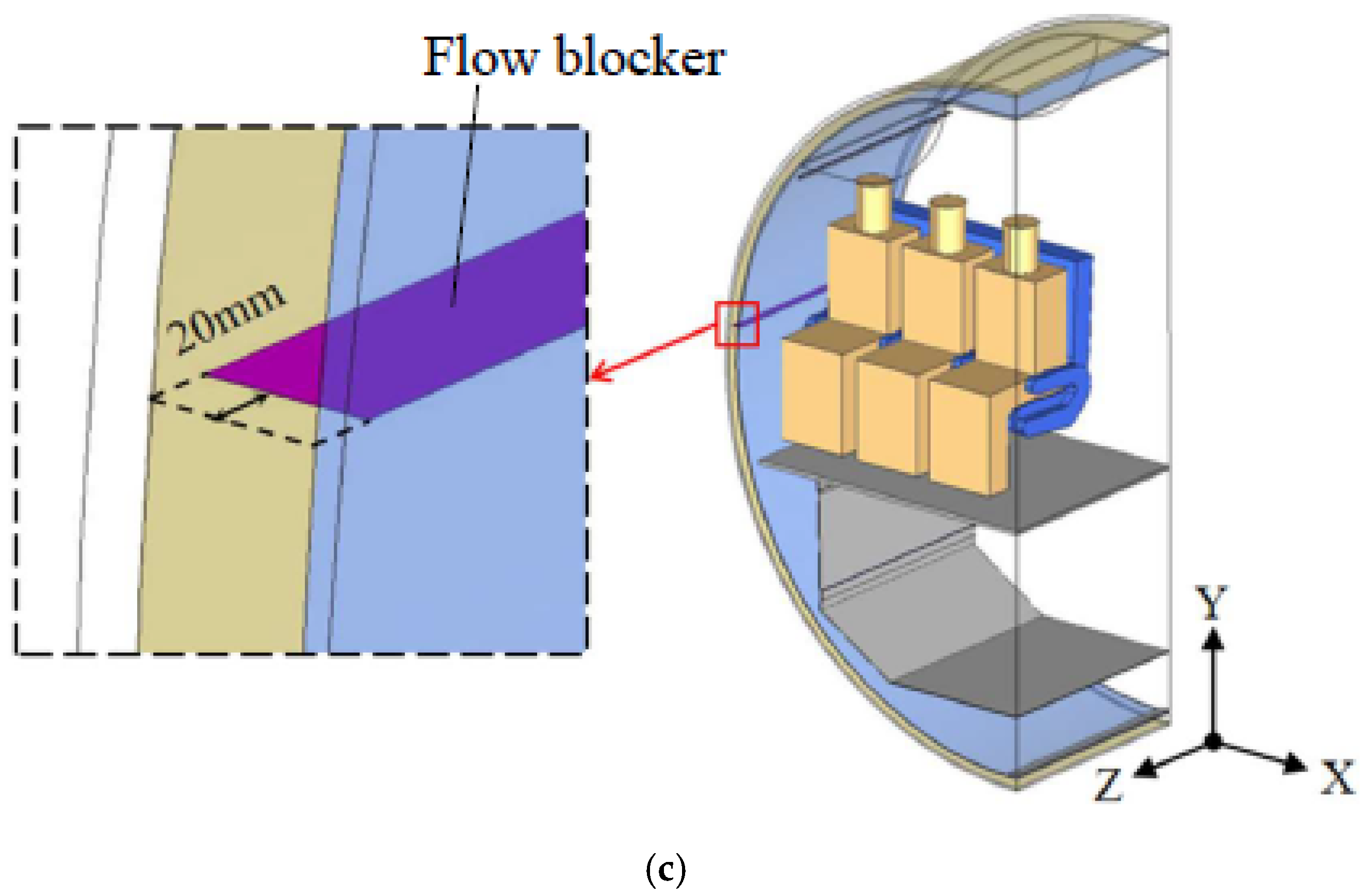




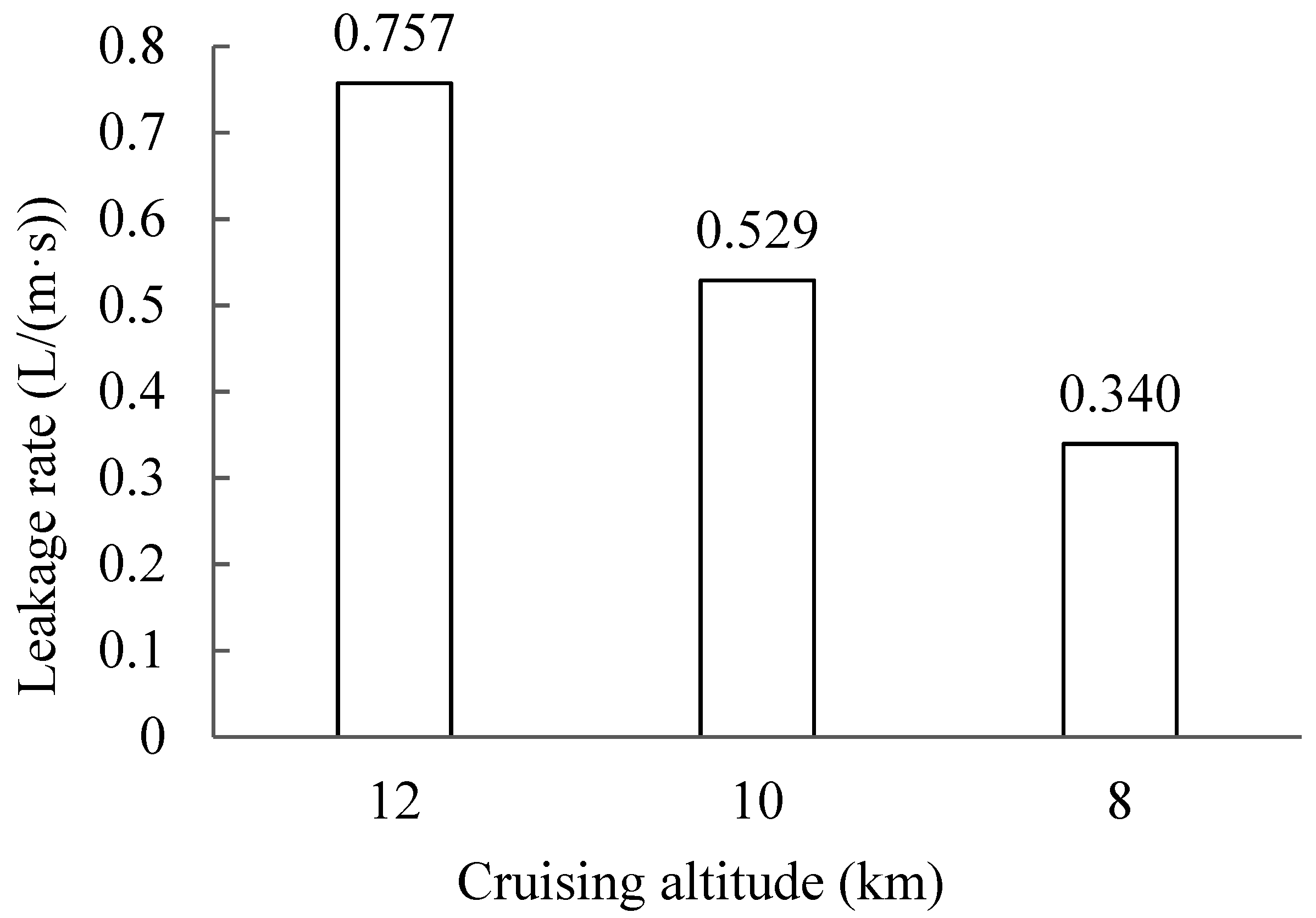
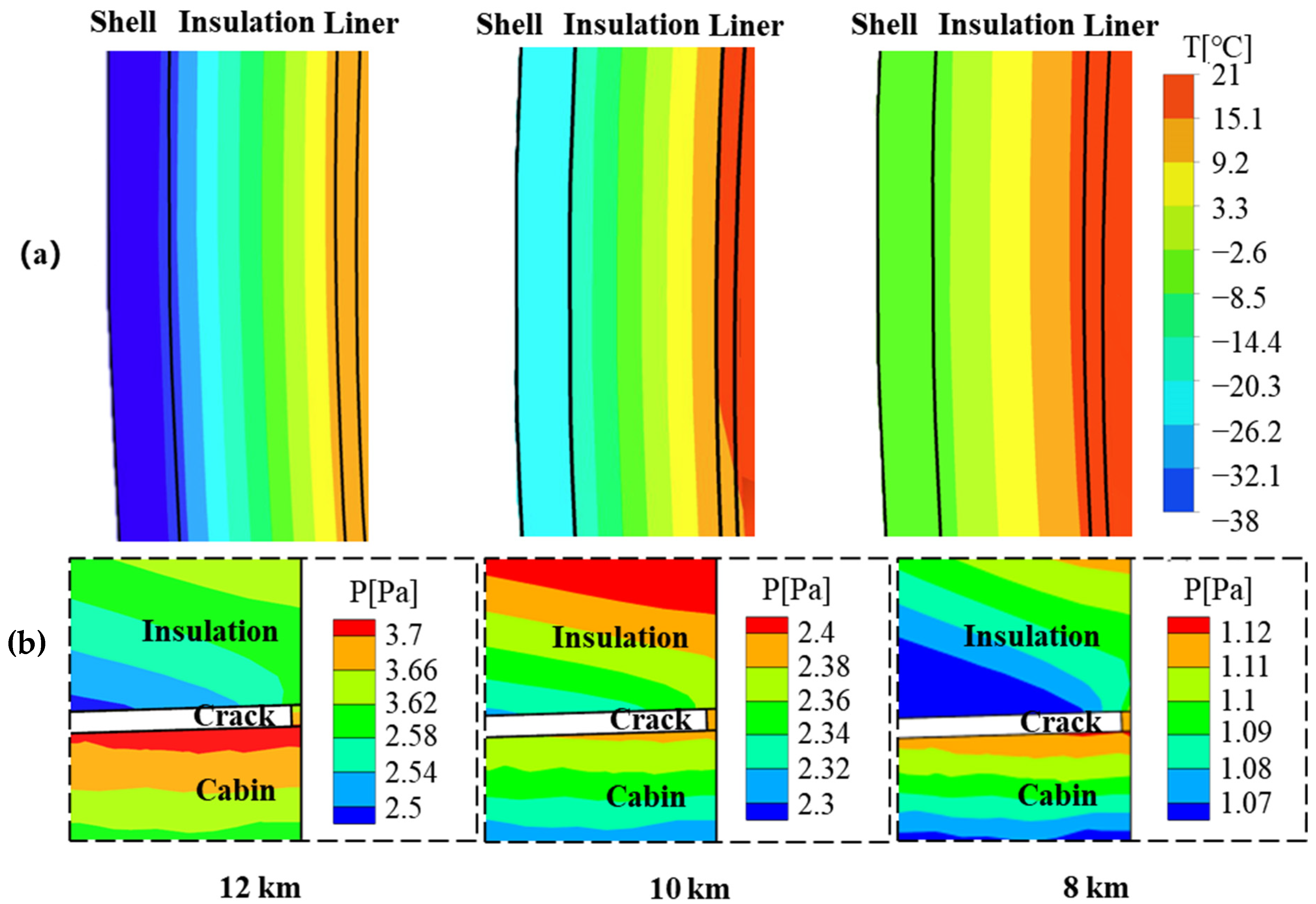
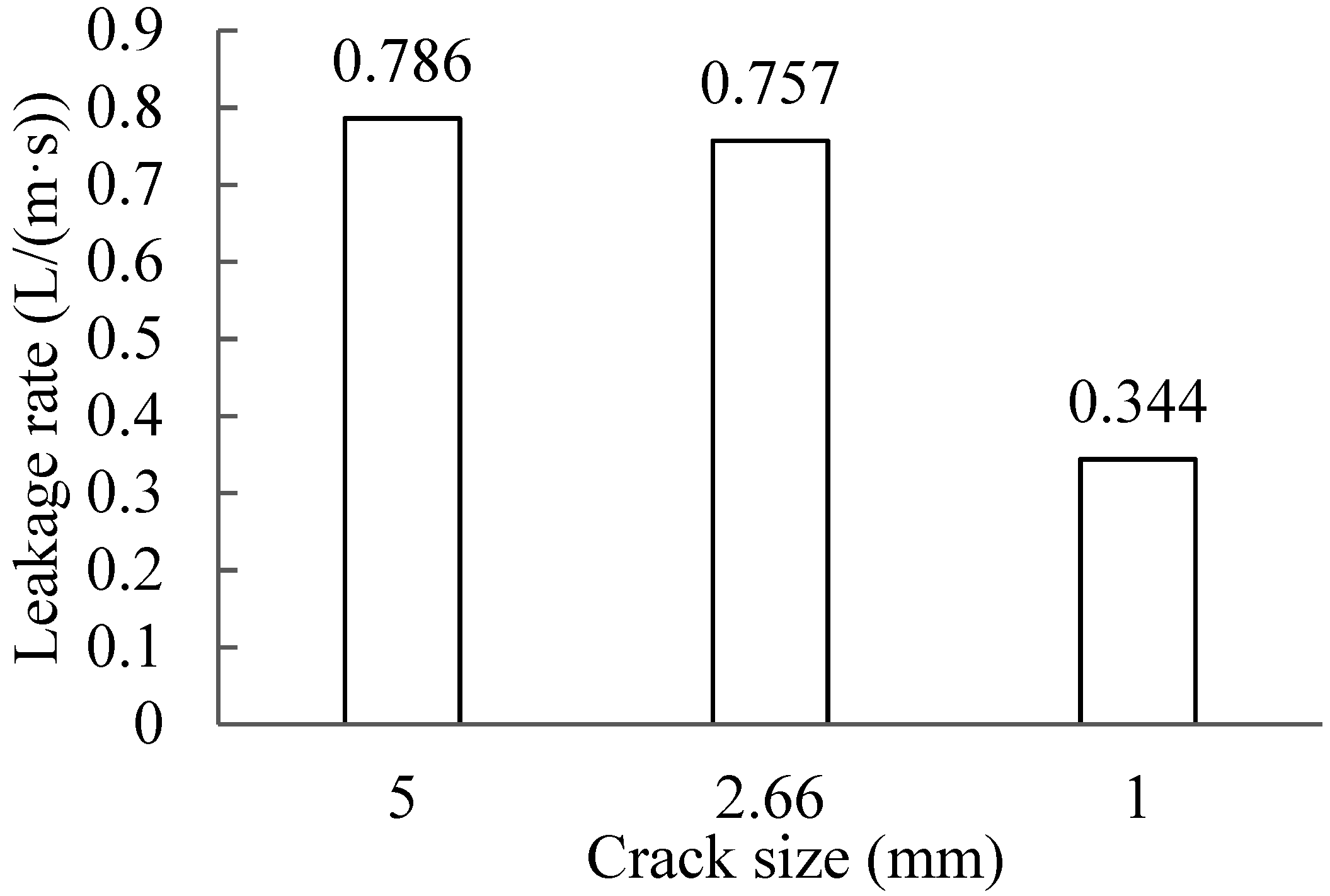

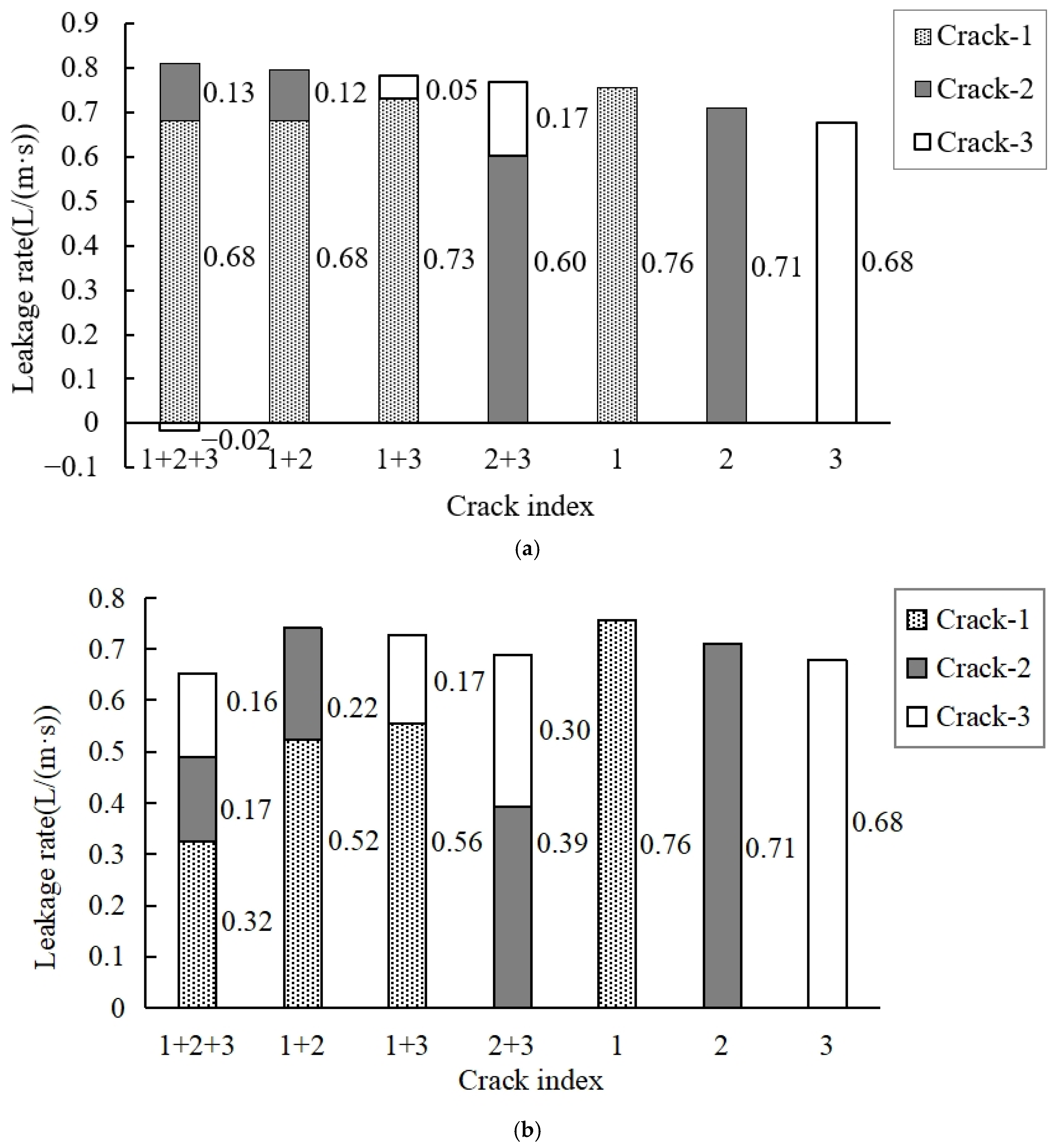
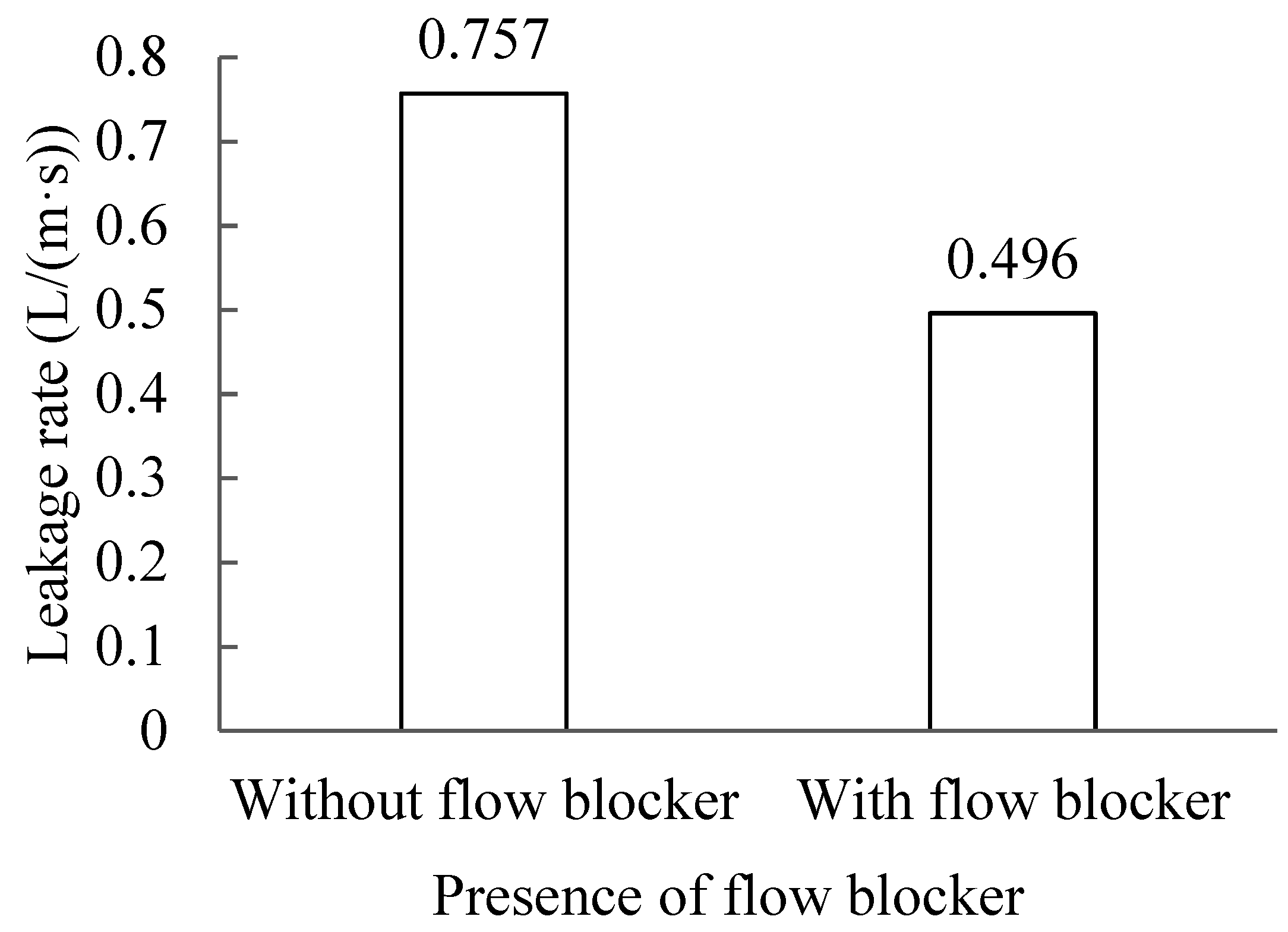

| Case | Cruising Altitude (km) | Crack Size (mm) | Cracks in Use | Flow Blocker |
|---|---|---|---|---|
| 1 | 12 | 2.66 | 1, 4 | No |
| 2 | 10 | 2.66 | 1, 4 | No |
| 3 | 8 | 2.66 | 1, 4 | No |
| 4 | 12 | 5 | 1, 4 | No |
| 5 | 12 | 1 | 1, 4 | No |
| 6 | 12 | 2.66 | 2, 4 | No |
| 7 | 12 | 2.66 | 3, 4 | No |
| 8 | 12 | Each: 2.66 | 1 + 2 + 3, 4 | No |
| 9 | 12 | Each: 2.66 | 1 + 2, 4 | No |
| 10 | 12 | Each: 2.66 | 1 + 3, 4 | No |
| 11 | 12 | Each: 2.66 | 2 + 3, 4 | No |
| 12 | 12 | Total: 2.66, each: 0.89 | 1 + 2 + 3, 4 | No |
| 13 | 12 | Total: 2.66, each: 1.33 | 1 + 2, 4 | No |
| 14 | 12 | Total: 2.66, each: 1.33 | 1 + 3, 4 | No |
| 15 | 12 | Total: 2.66, each: 1.33 | 2 + 3, 4 | No |
| 16 | 12 | 2.66 | 1, 4 | Yes |
| Boundary Surface | Boundary Type, Speed or Pressure | Temperature (°C) |
|---|---|---|
| Manikin surfaces | No-slip wall | 30 |
| Air-supply inlet (passenger cabin) | Velocity, 1.25 m/s | 21 |
| Air-exhaust outlet (passenger cabin) | Pressure outlet, 0 Pa | - |
| Air-supply inlet (cargo hold) | Velocity, 0.236 m/s | 20 |
| Air-exhaust outlet (cargo hold) | Pressure outlet, 0 Pa | - |
| Floor | No-slip wall | Adiabatic |
| Seat | No-slip wall | Adiabatic |
| Outer shell skin | No-slip wall | Convective heat transfer coefficient (h): 113.19 W/(m2 K) |
| Free steam temperature (Tfree): −37.3 | ||
| Sky radiant temperature (Tsky): −121 External emissivity (ε): 0.92 |
| Item | Density (kg/m3) | Specific Heat (J/(kg·K)) | Thermal Conductivity (W/(m·K)) | Porosity |
|---|---|---|---|---|
| Shell | 2719 | 871 | 155 | - |
| Insulation | 14.89 | 443.25 | 0.03 | 0.995 |
| Lining | 900 | 1926 | 0.367 | - |
| Air | Varying as ideal gas | 1005 | 0.0262 | - |
Publisher’s Note: MDPI stays neutral with regard to jurisdictional claims in published maps and institutional affiliations. |
© 2022 by the authors. Licensee MDPI, Basel, Switzerland. This article is an open access article distributed under the terms and conditions of the Creative Commons Attribution (CC BY) license (https://creativecommons.org/licenses/by/4.0/).
Share and Cite
Zhang, T.; Dong, J.; Liu, S. Modeling and Measuring the Leaked-Air Rate into the Insulation Layer of a Single-Aisle Aircraft Cabin. Buildings 2022, 12, 652. https://doi.org/10.3390/buildings12050652
Zhang T, Dong J, Liu S. Modeling and Measuring the Leaked-Air Rate into the Insulation Layer of a Single-Aisle Aircraft Cabin. Buildings. 2022; 12(5):652. https://doi.org/10.3390/buildings12050652
Chicago/Turabian StyleZhang, Tengfei (Tim), Jinsong Dong, and Sumei Liu. 2022. "Modeling and Measuring the Leaked-Air Rate into the Insulation Layer of a Single-Aisle Aircraft Cabin" Buildings 12, no. 5: 652. https://doi.org/10.3390/buildings12050652






